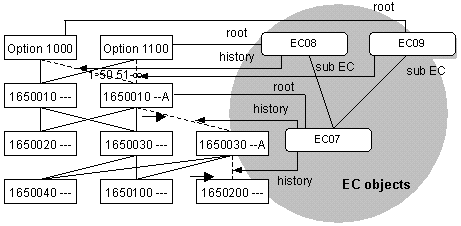Product Data Representation for EC Management: EC Object Implementation
in place August 19, 2000, last modified November 2, 2000 review 01
We have developed a web-based product information management system (PIM) that can support all the requirements proposed in this paper. Using a relational database management system and web programming languages, it translated the product data representation to relational tables and corresponding application programs. In this chapter, we illustrate the implementation for the last two items in the list of the requirements, the consistent EC management and access to EC data on different abstraction levels. The implementation for the rest of the requirements are prepared in the https://engdb.tripod.com/designdb/testbed/index.htm. To illustrate the implementation, we build an example EC for environmental regulations which reuse the previous example of the product structure changes.
A strict environmental regulation enforces the product to reduce its noise below 70 dB. To meet the regulation, designers decided to change the filter whose part number is 1650100 --- to new type of filter, 1650200 ---, and change the assembly structure of 1650010 --- as the previous example. The changes are recorded in an assembly type EC object whose identifier is EC07. Then, technical information for the EC is also stored in the EC object.
The EC of the assembly effects the two options, option 1000 and 1100, so engineers create two option type EC objects, EC08 and EC09 and record the structure change between the options and the assembly parts. The two EC objects will share the EC07 as their sub EC without any duplication or re-input of EC data. In addition, on the sub EC relationship, a structure related integrity constraint could be enforced. If the root of the assembly part of the EC07, 1650100 ---, has no constituent relationship with the option 1000 of the EC08, the EC08 can not contain the EC07 as its sub EC object. Figure 4 shows the windows of the EC of option ,EC08, and its sub EC, EC07.

Figure 4. Windows of the EC objects
The implementation expands the EC of assembly, the EC07, to capture its key inputs, output estimations and output results. In addition, the unstructured EC information should be recorded in the engineering notes. EC07 in the figure 4 shows its input parameters, the width and hight of its assembly and its output, the heat and nose. All the information is technical data or knowledge to change the assembly structure.
On the contrary, the EC of options contain the information on the different abstraction level from that of assembly type EC. They have more managerial or market-oriented information. The figure 4 shows that the EC08 contains the cause, target and output of the EC for the environmental regulation. The difference of abstraction levels is based on the proposed texanomy of EC and it is strongly related to the product structure.
Designers can access EC08, a EC of options, through the option 1100 and drill down into the more technical information through the sub EC, EC07. It also could show that EC08 and EC09 are effected by the EC07 through the where used operation. So designers can access all the data related to the EC through the EC objects and related product structures of options and assemblies and navigate all of them through the sub EC relationships and EC part relationships. Figure 5 shows the relationships of the EC objects and the product structure.

Figure 4. The Product Structure and The EC Objects in the Example
In the example, the implementation manages the EC data on different abstraction levels in different product structure maintaining relationship between them. It also allows the users to access each data and navigate between them for the purpose of market oriented or technical oriented data retrieving. This facility could make the representation as an integrated repository of EC in enterprise wide. In addition, since the EC objects are integrated into the product structure and the data representation are specified conventional data definition language (we use SQL), the relationship between EC and parts in the product structure can be easily retrieved in the various computing environment.
Knowledge & Engineering Databases (c) copyright Namchul Do, 2000